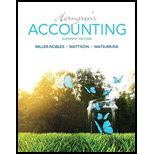
Concept Introduction
Profit Margin Ratio: Profit Margin Ratio is a financial profitability ratio that is used to compare a company’s net earnings and its net sales. It is calculated by dividing net income (or operating income) by net sales of a company for a particular period.
Return on Total Assets: Return on Total Assets (ROTA) is a financial profitability ratio that measures how effectively and efficiently a company utilizes its assets to generate profits during a period. It is calculated by dividing earnings before interest and tax (EBIT) by the average total assets for a particular period.
Asset Turnover Ratio: Asset Turnover Ratio is a financial efficiency ratio which is used to measure how efficiently a company is using its assets to generate sales. It is measured as the ratio of net sales to the average total assets of a company for a particular period.
Return on Common
Earnings per Share: Earnings per Share (EPS) is a financial profitability ratio that measures the amount of net income available to common stockholders earned on one share. It is calculated by dividing net income available to common stockholders by the average (or weighted average) number of shares outstanding during a period.
Dividend Payout Ratio: Dividend Payout Ratio is a financial ratio that shows the percentage of a company’s earnings that is paid in the form of dividends. It is calculated by dividing dividend per share by earnings per share (EPS) for a particular period.
Requirement 1
To Compute:
The profit margin ratio for 2017 and 2016.
Requirement 2
To Compute:
The
Requirement 3
To Compute:
The asset turnover ratio for 2017 and 2016.
Requirement 4
To Compute:
The rate of return on common stockholders’ equity for 2017 and 2016.
Requirement 5
To Compute:
The earnings per share for 2017 and 2016.
Requirement 6
To Compute:
The 2017 dividend payout on common stock.
Requirement 7
Whether the company’s operating performance improved or deteriorated during 2017.
Want to see the full answer?
Check out a sample textbook solution
Chapter 17 Solutions
Horngren's Accounting (11th Edition)
- BlueSky Corp has total debt of $250 million and 40 million shares outstanding with a market price of $5.50 per share. Calculate BlueSky's market debt-equity ratio. A) 1.52 B) 0.88 C) 1.14 D) 2.15arrow_forwardPlease need answer the general accounting question not use aiarrow_forwardGroot Co. (GC) sells $1,200,000 of 6-year, 10% bonds at par plus accrued interest. The bonds are dated January 1, 2026 but due to market conditions are not issued until May 1, 2026. Interest is payable on June 30 and December 31 each year. The market rate of interest at time of issue is the same as the stated rate. Required The issuance of the bonds on May 1, 2026. Assume that GC has adopted a policy of crediting accrued interest payable for the accrued interest on the date of sale. Payment of interest on June 30, 2026. Payment of interest on December 31, 2026.arrow_forward
- 1. Define working capital and explain its importance in financial health and liquidity management. 2. Assess how the matching concept and accrual basis affect the reporting of current assets and liabilities. 3. Using a hypothetical balance sheet (you may create one), identify at least 5 current assets and 5 current liabilities and analyze how changes in these elements affect liquidity ratios. 4. Recommend at least two strategies VinGrenDom Ltd. can implement to optimize working capital.arrow_forwardNonearrow_forwardNo Ai Answerarrow_forward
- I need the correct answer to this financial accounting problem using the standard accounting approach.arrow_forwardTheron Interiors manufactures handcrafted cabinetry and uses a process costing system. During the month of October, the company started Production on 720 units and completed 590 units. The remaining 120 units were 60% complete in terms of materials and 40% complete in terms of labor and overhead. The total cost incurred during the month was $45,000 for materials and $31,200 for labor and overhead. Using the weighted-average method, what is the equivalent unit cost for materials and conversion costs (labor and overhead)?arrow_forwardGeneral Accountingarrow_forward
- Kamala Khan has to decide between the following two options: Take out a student loan of $70,000 and study accounting full time for the next three years. The interest on the loan is 4% per year payable annually. The principle is to be paid in full after ten years. Study part time and work part time to earn $15,000 per year for the following six years. Once Kamala graduates, she estimates that she will earn $30,000 for the first three years and $40,000 the next four years. Kamala's banker says the market interest for a ten-year horizon is 6%. Required Calculate NPV of the ten-year cash flows of the two options. For simplification assume that all cash flows happen at year-end. Based on the NPV which of the two options is better for Kamala?arrow_forwardFinancial Accountingarrow_forwardPlease give me answer with general accountingarrow_forward

 AccountingAccountingISBN:9781337272094Author:WARREN, Carl S., Reeve, James M., Duchac, Jonathan E.Publisher:Cengage Learning,
AccountingAccountingISBN:9781337272094Author:WARREN, Carl S., Reeve, James M., Duchac, Jonathan E.Publisher:Cengage Learning, Accounting Information SystemsAccountingISBN:9781337619202Author:Hall, James A.Publisher:Cengage Learning,
Accounting Information SystemsAccountingISBN:9781337619202Author:Hall, James A.Publisher:Cengage Learning, Horngren's Cost Accounting: A Managerial Emphasis...AccountingISBN:9780134475585Author:Srikant M. Datar, Madhav V. RajanPublisher:PEARSON
Horngren's Cost Accounting: A Managerial Emphasis...AccountingISBN:9780134475585Author:Srikant M. Datar, Madhav V. RajanPublisher:PEARSON Intermediate AccountingAccountingISBN:9781259722660Author:J. David Spiceland, Mark W. Nelson, Wayne M ThomasPublisher:McGraw-Hill Education
Intermediate AccountingAccountingISBN:9781259722660Author:J. David Spiceland, Mark W. Nelson, Wayne M ThomasPublisher:McGraw-Hill Education Financial and Managerial AccountingAccountingISBN:9781259726705Author:John J Wild, Ken W. Shaw, Barbara Chiappetta Fundamental Accounting PrinciplesPublisher:McGraw-Hill Education
Financial and Managerial AccountingAccountingISBN:9781259726705Author:John J Wild, Ken W. Shaw, Barbara Chiappetta Fundamental Accounting PrinciplesPublisher:McGraw-Hill Education





